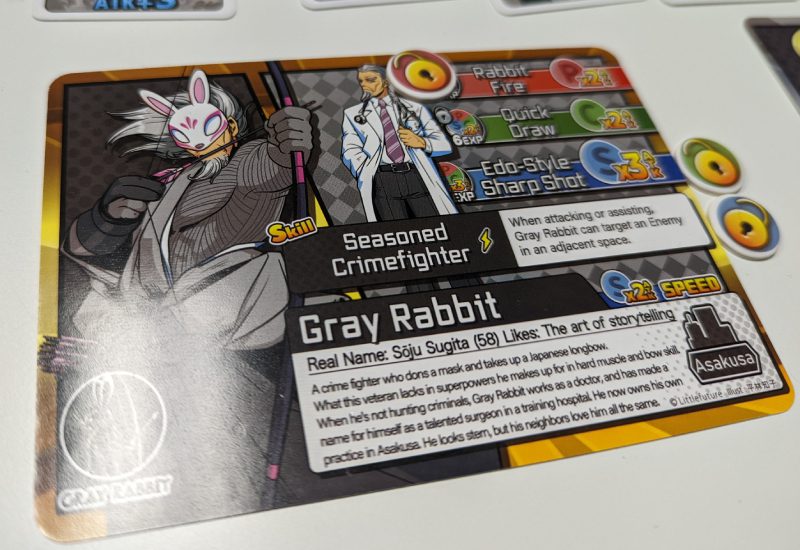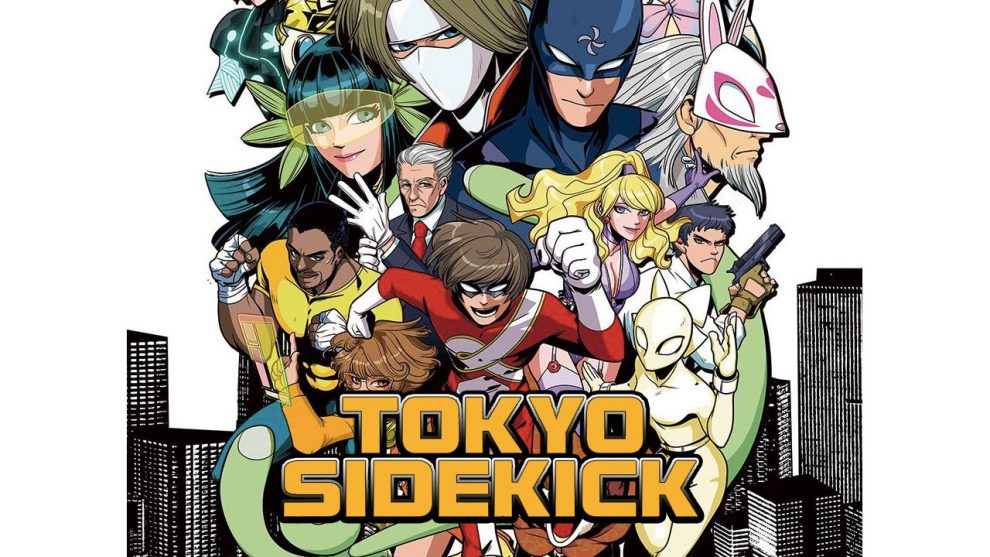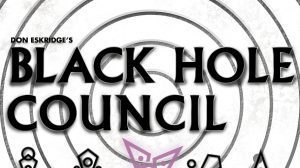Disclosure: Meeple Mountain received a free copy of this product in exchange for an honest, unbiased review. This review is not intended to be an endorsement.
When I started writing board game reviews two years ago, I wasn’t planning to review cooperative games.
Playing a game that made me feel like I was in a meeting where everyone spoke different languages never appealed to me. However, I wanted to see if the cooperative genre had changed for the better, so I gave it another shot. For whatever reason, most of the games I ended up reviewing were of the Asian variety, with games such as Debtzilla and Testament. Today’s game, Tokyo Sidekick, is joining that circle.
As you can probably tell based on the name, Tokyo Sidekick is about Superheroes, and the plot doesn’t stray too far from expectations. Incidents have flooded the city as if Noah’s Ark was on its way. Regular Villians and Supervillians are ravaging the locals with the big Menace pulling the strings.
How are you going to solve this problem? Like most problems in life, with violence. You and your friends will form a violence committee by handpicking Superheroes and their Sidekicks, with every one of them having their little power to toy around with.
Enough with the prologue, we have a city to save.
Time to get big
And this city is represented by a giant board that might as well have its own postal code. Each spot on the map represents an area with connecting pathways. The characters you chose have fixed starting positions, followed by a randomly selected Villain that also has a fixed starting point. The starting Incidents are also fixed, so you will need to deal with the overturned tanker on the other side of the map at the start of every session of Tokyo Sidekick.
Besides your character cards, you also have a player mat and a deck of cards. You draw five cards from your deck representing the three resource types: Power, Speed, and Concentration. On your turn, you spend resources to do various actions, and after finishing your turn, you discard your hand and draw five more. Each undefeated Villain on the board gives you one damage card in your discard pile, which clogs up your deck. If the deck runs out, you reshuffle your discard to form a new deck.
Most actions in this game do not care what resource type you use. If you want to move, spend one resource. If you wish to draw an extra card, spend two. You can perform all basic actions from the player mat.
The two actions that require specifics are your Resolve and Fight actions. Resolving is where the Incidents come in. If your character is on the space with an Incident, pay its cost listed on the Incident card, remove it, and gain XP. Simple.

Say hello with your fists, not a handshake
Fighting is not as direct. Every Villain has their own rule-breaking gimmick as well as a Shield and Health value. When you strike, you spend resources to give you an Attack. The first Fight action needs to break the Shield, followed by a second Fight action to overcome their Health to defeat the Villain.
Typically, one resource would mean one Attack. However, each hero has a specialty, and if they use that specialty, it multiples their Attack by 2. For example, if you assign 3 Concentration on your Concentration specialty hero, it’s 6 Attack.
That sounds sweet, but it gets better. If both of your characters are attacking the Villain by assigning resources to both of them, they get a Dynamic Duo bonus that rewards you with more Attack. Other players can also assist you, contributing to the Attack and triggering their Dynamic Duos. Whether it is breaking a Shield or giving the final blow to their Health, anyone who contributes to the Fight gets XP.
After finishing your turn, you will draw a new hand, undefeated Villains will damage you, and a new Incident occurs. You will know the Incidents in advance thanks to a queuing system, but if that queue is empty, another series of steps will happen before you refill it. A new villain will show up, both yellow and red Incidents damage the city, and red Incidents will get a flame token. If you run out of damage cards and need to draw more, you lose. If the city’s hit points go to zero, you lose. If a red Incident gets a second flame token, you also lose.
Like most cooperative games, there are many ways to lose and only one way to win. In this case, you win by defeating two Villains, two Supervillians, and finally the big bad Menace.
Wait a minute
I know some of you who are well-versed in the cooperative genre are probably thinking…
“There’s nothing new here”
And to be fair, my first impressions were the same. A big map full of problems that need to be resolved, a few player pieces on the board, and a heavy emphasis on resource management to make sure the situation doesn’t get out of hand. It is a story told more often than Batman’s origins.
Yet it’s that XP system where Tokyo Sidekick takes out its knife and carves its own identity on the proverbial tree.
Tokyo Sidekick’s gameplay loop consists of running around to resolve Incidents and fighting Villains, earning XP, and spending XP to grow your character for upcoming threats. It sounds simple until you realize that developing your character involves a buffet of options.
Options like buying more resource cards for your deck, or unlocking your Superhero skill cards to go beyond the basic actions. For those into combat, the Dynamic Duo bonus can be upgraded. You can give your Sidekick a gadget card, so they have the same specialization as your Superhero. Additionally, Superhero attacks can be upgraded by giving attack multipliers for other resource types and improving their own specialization bonus.

Growing yourself right
It’s difficult to pick the right upgrades here without considering the many factors of the situation your team is in and understanding your team’s capabilities. Since XP is a scarce resource, planning is vital. It’s also impossible to upgrade every part of your character, so you need to be efficient with the resources you have.
Despite the Superhero presentation, this is not a power fantasy game. Playing Superheroes with your friends means nothing if you’re uncoordinated. Tokyo Sidekick has no issues using your face to explore the dirt under your feet if you make mistakes. The game expects you to learn its tricks and gimmicks before you have any chance of success.
It’s quite possible to fail before you even begin the first turn simply due to poor team composition. Teamwork is everything in Tokyo Sidekick and the proper approach is to treat this like a roleplaying game. Power characters are designed to fight Villains, Speed characters want to resolve incidents, and Concentration characters strive to make sure the ship isn’t sinking too quickly while the team is getting blasted. Going outside of three main areas can work with your chosen character, but you don’t want to stray too far from the designed path.
Upgrades are another potential area of failure. Although all upgrades are good, they don’t work in every situation. A failure to recognize upcoming threats or an improper response will cause collective suffering. A common failure point I saw in my games was picking upgrades that were barely utilized well, thereby wasting the XP.
It sounds bad, and it is, but it is also why wins in this game are so sweet.
Tasting victory
Once you understand what is going on and make the right decisions, the game’s dynamics shift slowly. You are no longer surviving the situation, but styling on it. You and your friends become anime directors of a season finale, with every one of you barking suggestions on how to daisy chain your team’s powers to make the best show possible.
The characters’ powers can even lead to different solutions to the same problems they will face. Eau de Glamour can force Villains to move towards Hero spaces to force a fight, while James Kiritani has a Battlemobile that can Uber the other characters around the city. Alpha Kid can move to his Superhero for free, and everyone’s favorite Shiba Inu sidekick, Chamaru, can move around for free. That’s just the Sidekicks.
Heroes also have their own skills and powers. Grey Rabbit can attack from adjacent spaces and hop to any other player character. Samuraiman—yes, it’s spelled like that—is a walking human blender that can shred most Villains with ease, while Melty Sweet can interrupt other players’ turns to do her actions. Plenty of tools and replayability are present here.
I have to say that when I won my first four-player game of Tokyo Sidekick, I was impressed. Even though it is a challenging game, it is one of the few that will shower your group with a sense of satisfaction after you have gone through so much to figure it out.
I also did beat this game solo, which is almost identical to two players, by controlling two teams of superheroes and sidekicks. I can’t think of a family-friendly word to describe my displeasure.
It’s easy to tell why this is the case if you have beaten the game at the four-player count.

A job too big for two
The first warning is the map size doesn’t change. In a four-player game, you have 8 player tokens to help you fight and resolve incidents. In a solo or two-player, you only have 4. This means you need to spend more resources to move your characters to fight or resolve, and you cannot get any decent assistance when fighting. The Shield and Health values of the Villains do not change either. Most of my losses were often running out of damage cards because the Incidents took too many resources and we couldn’t fight off the Villains.
An easy solution would’ve been something along the lines of a dummy team of a Superhero and Sidekick that both players can use, a better starting deck, or some XP at the beginning of the game.
Since I am on the topic of difficulty, Tokyo Sidekick can sometimes feel as consistent as the Tesla stock price.
The Incident deck consists of red, yellow, and green Incidents. Nothing wrong with that, but there is no system of difficulty progression where the game builds up over time. Instead, it’s completely shuffled, meaning it is quite possible to have your first three upcoming Incidents be red as if they were sponsored by Ferrari. Not only do these red Incidents threaten to end your game quickly, but you need two resources of a specific type to resolve them. Considering that you only have five or six resources per turn at the start of the game, that is a tall order to fill.
An inconsistent story
Villains are also a culprit of this randomness issue. Each Villain has a hero they are Fated with. If the Hero fights them, there is often a perk, with most of them being “ignore the Villains special ability” which obviously makes it easier to fight. There are also some powers of the Villains that can upscale or downscale the difficulty quite severely. Both Jinx Cat and Cool Guy can possibly join your team if you beat them, giving you more player tokens on the field. On the other side, the Supervillain Kabuki immediately adds three red incidents on the board when he arrives. Ouch.
Tokyo Sidekick can be unfair due to circumstances beyond your control. I don’t mind this too much since this forces me and my friends to think of new solutions in every session instead of following formulas like in other cooperative games. The concept, though, might turn off many players.
This does leave Tokyo Sidekick in a weird spot. At its four-player peak, this is an enjoyable ride that demands you understand everything it offers to reach its destination. Even though it’s as unpredictable as adopting a wild animal, it’s the unforeseen circumstances that make good superhero stories. On the other side of the spectrum, I can’t ignore how poorly this plays at lower player counts. The cooperative genre is full of great games and there are simply far better options out there for those seeking a solo or two-player game.












Add Comment